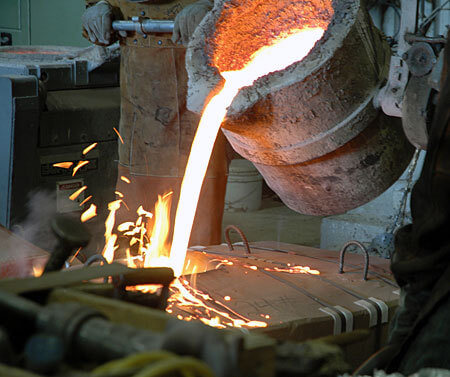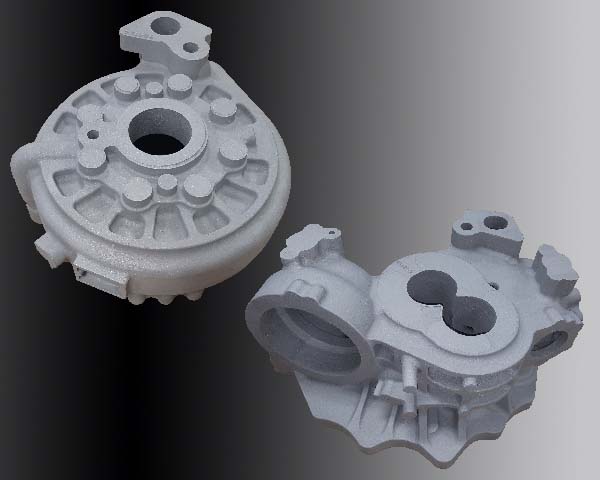Discover how modern Precision aluminum casting enhances product performance
Exploring the Cutting-edge Processes Behind Modern Aluminum Factory Operations
Modern aluminum factory procedures are going through significant makeover. Automation and AI are improving manufacturing approaches, improving both efficiency and precision. The assimilation of 3D printing is simplifying mold creation, while sustainability methods are becoming a lot more vital. Each of these advancements plays a vital function in redefining the industry. The effects of these adjustments expand beyond simple production effectiveness. What chances and obstacles lie in advance for light weight aluminum factories in this advancing landscape?
The Duty of Automation in Light Weight Aluminum Foundries

Automation adds to boosted safety criteria within the shop environment. By moving unsafe tasks to makers, human workers can concentrate on managerial duties and quality assurance, minimizing the threat of crashes. On top of that, data analytics stemmed from automated processes offer useful understandings right into functional efficiency, causing much better decision-making and continuous improvement. As the demand for aluminum products grows, the fostering of automation technologies will likely broaden, even more transforming the landscape of light weight aluminum shop operations.
Improvements in Casting Technologies
Current improvements in casting technologies are transforming light weight aluminum factory operations. Advancements such as 3D printing assimilation, advanced alloy formulas, and automated process optimization are improving effectiveness and item quality. These growths are pivotal in satisfying the advancing needs of the industry.
3D Printing Assimilation
Incorporating 3D printing innovation right into light weight aluminum factory operations has actually revolutionized standard spreading techniques, improving both performance and accuracy. This innovative method permits the fast manufacturing of complicated molds and cores, greatly decreasing preparations and material waste. By utilizing additive manufacturing, factories can produce intricate geometries that were formerly difficult or impossible to achieve with traditional methods. The adaptability of 3D printing likewise makes it possible for fast layout modifications, fostering a more dexterous production process. In addition, this integration sustains the usage of lightweight frameworks, which is progressively essential in sectors such as vehicle and aerospace. As light weight aluminum factories remain to take on 3D printing, they position themselves at the center of technical innovation, driving improvements in product high quality and functional capabilities.
Advanced Alloy Formulations
The development of advanced alloy formulas has actually substantially boosted spreading technologies in aluminum shop operations. These solutions integrate numerous components, such as magnesium, silicon, and copper, to improve mechanical residential properties and thermal resistance. By tailoring the composition of aluminum alloys, producers can accomplish details efficiency attributes that fulfill the demands of diverse applications, from automotive elements to aerospace structures. Making use of innovative alloys likewise adds to minimized weight and boosted stamina, which are vital factors in contemporary engineering. Furthermore, technologies in alloy development allow better fluidity throughout casting, resulting in improved surface area finishes and lowered problems. Generally, progressed alloy formulas stand for a significant jump onward, placing aluminum factories to satisfy the developing requirements of numerous sectors successfully.
Automated Refine Optimization
Developments in casting technologies have led the way for automatic procedure enhancement in aluminum foundry operations. By integrating innovative software and real-time data analytics, factories can now improve manufacturing procedures and enhance high quality control. Automated systems monitor variables such as stress, air conditioning, and temperature level prices, enabling prompt modifications that minimize flaws and waste. Additionally, artificial intelligence formulas analyze historic performance data to forecast optimal setups, thereby boosting efficiency and lowering cycle times. Robotics additionally play a considerable role, dealing with repeated tasks that enhance safety and accuracy. On the whole, these innovations not just drive functional efficiency but also allow factories to fulfill the expanding need for high-quality light weight aluminum parts in numerous industries.
Smart Production and Sector 4.0 Combination
The integration of Smart Manufacturing and Sector 4.0 within aluminum foundries is changing functional efficiency. By leveraging IoT modern technologies, automation, and robotics, shops can optimize manufacturing procedures and minimize downtime. Additionally, information analytics gives crucial insights that boost decision-making and drive continual renovation.
IoT in Shop Workflow
As manufacturers increasingly welcome the Web of Points (IoT), factory operations are experiencing a transformative change in the direction of wise manufacturing and Sector 4.0 combination. Aluminum Foundry. IoT modern technologies make it possible for real-time data collection and evaluation, improving decision-making procedures and functional performance. Sensing units and linked devices keep track of devices efficiency, material usage, and environmental conditions, permitting positive maintenance and resource optimization. This connectivity promotes an extra active manufacturing setting, where adjustments can be made swiftly in action to market needs. In addition, IoT facilitates improved traceability and quality assurance, as information from the whole production cycle can be easily accessed and evaluated. In general, the assimilation of IoT in factory operations substantially enhances productivity and drives innovation in aluminum manufacturing procedures
Automation and Robotics Integration
Automation and robotics combination is transforming light weight aluminum factory operations by enhancing effectiveness and accuracy. This transformative method enhances procedures such as molding, pouring, and completing, lowering human mistake look at here now and raising output uniformity. By using innovative robotic systems, factories can attain higher manufacturing rates while maintaining rigid quality criteria. Automated systems likewise enable real-time tracking and flexible control, allowing for swift modifications to production specifications. Furthermore, the combination of robotics minimizes labor expenses and alleviates safety threats associated with hands-on handling of liquified steel. As factories accept clever production concepts fundamental in Industry 4.0, the harmony between automation and robotics strengthens their affordable edge, leading the way for lasting development and development in the light weight aluminum casting sector.
Data Analytics for Efficiency
Harnessing data analytics substantially improves efficiency within light weight aluminum foundry procedures, straightening with wise manufacturing and Sector 4.0 principles. By leveraging real-time information collection and analysis, foundries can monitor production processes, anticipate devices failures, and optimize source allotment. This data-driven strategy assists in insightful decision-making, making it possible for managers to identify bottlenecks and enhance operations. Furthermore, predictive analytics encourages shops to anticipate market needs, thus lowering waste and guaranteeing prompt item shipment. Integration of data analytics with IoT tools improves operational exposure, fostering a proactive upkeep culture. Inevitably, applying these advanced logical techniques not only boosts performance however also drives development, positioning aluminum foundries to fulfill the evolving needs of the sector while maintaining competitive edges in a quickly altering landscape.
Lasting Practices in Light Weight Aluminum Casting
While the aluminum spreading sector has actually traditionally faced environmental challenges, lots of shops are currently taking on lasting methods to alleviate their effect (aluminum casting). A considerable focus has gotten on recycling light weight aluminum scrap, which not just reduces waste however also preserves energy compared to main light weight aluminum manufacturing. Cutting-edge melting technologies, such as induction furnaces, boost power performance and lower greenhouse gas exhausts
Additionally, factories are implementing closed-loop water systems to reduce water intake and decrease thermal pollution. Using eco-friendly binders in mold-making procedures is getting traction, additional reducing dangerous emissions.
Some facilities my response are investing in eco-friendly power sources to power procedures, lining up with global sustainability goals. By incorporating these practices, the light weight aluminum spreading sector is developing towards a much more eco liable future, showing that economic growth can exist side-by-side with eco-friendly stewardship - Aluminum Foundry. These initiatives show a dedication to sustainability and the relevance of ecological liability in manufacturing
Quality Assurance Innovations
As the aluminum spreading industry advances in the direction of sustainability, the value of high quality control technologies comes to be progressively evident. Modern light weight aluminum foundries are adopting sophisticated technologies to improve their top quality assurance processes. Methods such as real-time tracking and data analytics permit manufacturers to detect defects and inconsistencies early in the production cycle. Implementing computerized inspection systems equipped with equipment finding out algorithms guarantees that items satisfy rigid high quality criteria while lessening human mistake.
The combination of non-destructive screening methods, such as radiographic and ultrasonic examinations, supplies much deeper insights into the integrity of castings without harming the material. These innovations not only boost item reliability but also lower waste, aligning with sustainability objectives. Furthermore, the adoption of standardized high quality structures assists simplify operations throughout various factories, assuring consistency in output. Collectively, these advancements are reshaping high quality control, promoting a society of excellence within the aluminum casting market.
Future Trends in Light Weight Aluminum Foundry Operations
What technologies lie ahead for aluminum foundry operations? The future of light weight aluminum shops is poised for makeover via developments in automation, artificial knowledge, and lasting methods. The assimilation of robotics and automated systems is anticipated to enhance effectiveness and precision in the casting processes, minimizing human error and labor costs. Furthermore, AI-driven analytics will certainly make it possible for real-time surveillance and anticipating maintenance, optimizing operational performance and decreasing downtime.
Sustainability continues to be a prime focus, with shops progressively adopting environmentally friendly techniques, such as using recycled light weight aluminum and creating low-emission melting technologies. Technologies in 3D printing are additionally expected to transform mold-making, enabling for complicated geometries and lowered product waste. As the industry welcomes digitalization, data-driven decision-making will certainly become crucial, making it possible for foundries to react promptly to market demands. Jointly, these fads promise to redefine light weight aluminum foundry operations, making them much more reliable, lasting, and adaptable to future obstacles.

Often Asked Inquiries
What Security Procedures Are Carried Out in Aluminum Foundry Operations?
Aluminum factory procedures implement different security measures, including personal protective tools, air flow systems to manage fumes, routine safety training, emergency action plans, and stringent monitoring of temperature and devices to avoid crashes and guarantee worker safety and security.
Just How Do Factories Handle Workforce Educating for New Technologies?

What Products Are Frequently Reused in Aluminum Foundries?
Light weight aluminum foundries frequently reuse scrap light weight aluminum, including post-consumer items like drink cans, automobile components, and building products. This reusing procedure lowers waste and preserves sources, contributing to a more lasting aluminum production market.
Exactly How Does Aluminum Casting Influence the Setting?
Light weight aluminum casting impacts the atmosphere with energy-intensive procedures, greenhouse gas discharges, and potential local pollution. Nonetheless, innovations in reusing and sustainable practices can reduce these results, advertising an extra green technique to light weight aluminum manufacturing.
What Are the Normal Lead Times for Light Weight Aluminum Spreading Projects?
Common lead times for aluminum casting tasks vary substantially, generally ranging from two to six weeks. Factors affecting these timelines include complexity, order size, and product accessibility, impacting total production routines in foundry operations.
Automation progressively plays an essential role in aluminum foundries, enhancing performance and accuracy in the manufacturing procedure. Innovations in casting innovations have led the method for automated process enhancement in light weight aluminum factory operations. Taking advantage of data analytics greatly improves performance within aluminum foundry procedures, lining up with wise production and Sector 4.0 concepts. A substantial focus has actually been on reusing aluminum scrap, which not just minimizes waste however likewise preserves energy compared to key aluminum manufacturing. Light weight aluminum factories view it commonly reuse scrap light weight aluminum, consisting of post-consumer products like beverage canisters, automotive components, and construction products.